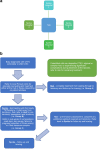A 'Hub and Spoke' Shared Care initiative for CTEV Ponseti service
- PMID: 37963491
- PMCID: PMC10645486
- DOI: 10.1302/2633-1462.411.BJO-2023-0076.R1
A 'Hub and Spoke' Shared Care initiative for CTEV Ponseti service
Abstract
Aims: The Ponseti method is the gold standard treatment for congenital talipes equinovarus (CTEV), with the British Consensus Statement providing a benchmark for standard of care. Meeting these standards and providing expert care while maintaining geographical accessibility can pose a service delivery challenge. A novel 'Hub and Spoke' Shared Care model was initiated to deliver Ponseti treatment for CTEV, while addressing standard of care and resource allocation. The aim of this study was to assess feasibility and outcomes of the corrective phase of Ponseti service delivery using this model.
Methods: Patients with idiopathic CTEV were seen in their local hospitals ('Spokes') for initial diagnosis and casting, followed by referral to the tertiary hospital ('Hub') for tenotomy. Non-idiopathic CTEV was managed solely by the Hub. Primary and secondary outcomes were achieving primary correction, and complication rates resulting in early transfer to the Hub, respectively. Consecutive data were prospectively collected and compared between patients allocated to Hub or Spokes. Mann-Whitney U test, Wilcoxon signed-rank test, or chi-squared tests were used for analysis (alpha-priori = 0.05, two-tailed significance).
Results: Between 1 March 2020 and 31 March 2023, 92 patients (139 feet) were treated at the service (Hub 50%, n = 46; Spokes 50%, n = 46), of whom nine were non-idiopathic. All patients (n = 92), regardless of allocation, ultimately achieved primary correction, with idiopathic patients at the Hub requiring fewer casts than the Spokes (mean 4.0 (SD 1.4) vs 6.9 (SD 4.4); p < 0.001). Overall, 60.9% of Spokes' patients (n = 28/46) required transfer to the Hub due to complications (cast slips Hub n = 2; Spokes n = 17; p < 0.001). These patients ultimately achieved full correction at the Hub.
Conclusion: The Shared Care model was found to be feasible in terms of providing primary correction to all patients, with results comparable to other published services. Complication rates were higher at the Spokes, although these were correctable. Future research is needed to assess long-term outcomes, parents' satisfaction, and cost-effectiveness.
© 2023 Hussain et al.
Conflict of interest statement
The authors have no conflict of interests to declare.
Figures
References
LinkOut - more resources
Full Text Sources
Miscellaneous



